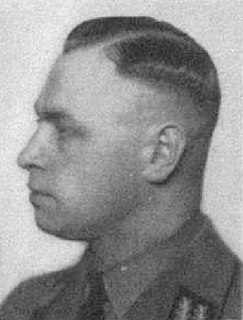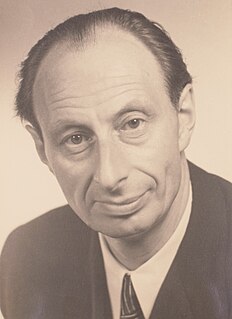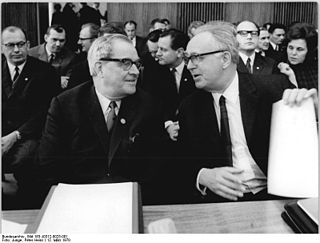 W
WHermann Aubin was a German historian.
 W
WArtur Axmann was the German Nazi national leader (Reichsjugendführer) of the Hitler Youth (Hitlerjugend) from 1940 to 1945, when the war ended. He was the last living Nazi with a rank equivalent to Reichsführer.
 W
WAlbert Battel was a German Army lieutenant and lawyer recognized for his resistance during World War II to the Nazi plans for the 1942 liquidation of the Przemyśl Jewish ghetto. He was posthumously recognized as Righteous Among the Nations in 1981.
 W
WGottlob Christian Berger was a senior German Nazi official who held the rank of SS-Obergruppenführer und General der Waffen-SS and was the chief of the SS Main Office responsible for Schutzstaffel (SS) recruiting during World War II. At the post-war Nuremberg trials, the Waffen-SS – within which Berger was a senior officer – was declared to be a criminal organisation due to its major involvement in war crimes and crimes against humanity. Berger was convicted as a war criminal and spent six and a half years in prison.
 W
WWilhelm Heinrich Otto Dix was a German painter and printmaker, noted for his ruthless and harshly realistic depictions of German society during the Weimar Republic and the brutality of war. Along with George Grosz and Max Beckmann, he is widely considered one of the most important artists of the Neue Sachlichkeit.
 W
WFriedrich Karl Florian was the Gauleiter of Gau Düsseldorf throughout its existence in Nazi Germany.
 W
WWieland Förster is a German sculptor, artist and writer. A recurring theme of his work is victimhood, reflecting his own youthful experiences during the incineration of Dresden in February 1945 and of the Soviet justice system between 1946 and 1950.
 W
WJosef Grohé was a German Nazi Party official. He was the long-serving Gauleiter of Gau Cologne-Aachen and Reichskommissar for Belgium and Northern France toward the end of the Second World War.
 W
WRolf Oskar Ewald Günter Herricht was an East German comedian.
 W
WErnst Hermann Himmler was a German Nazi functionary, engineer and younger brother of Reichsführer-SS Heinrich Himmler.
 W
WHeinrich Luitpold Himmler was Reichsführer of the Schutzstaffel, and a leading member of the Nazi Party (NSDAP) of Germany. Himmler was one of the most powerful men in Nazi Germany and a main architect of the Holocaust.
 W
WJoachim Jastram was a German sculptor.
 W
WHugo Jury was an Austrian Nazi. He held the offices of Gauleiter of Reichsgau Niederdonau and Reichsstatthalter for Lower Austria. He committed suicide at the end of the war in Europe.
 W
WKarl Kaufmann was a German politician who served as a Nazi Party Gauleiter from 1925 to 1945 and as the Reichsstatthalter of Hamburg from 1933 to 1945.
 W
WErich Koch was a Gauleiter of the Nazi Party (NSDAP) in East Prussia from 1 October 1928 until 1945. Between 1941 and 1945 he was Chief of Civil Administration of Bezirk Bialystok. During this period, he was also the Reichskommissar in Reichskommissariat Ukraine from September 1941 until August 1944 and in Reichskommissariat Ostland from September 1944. After the Second World War, Koch stood trial in Poland and was convicted in 1959 of war crimes and sentenced to death. The sentence was never carried out and Koch died of natural causes in his cell at the Barczewo prison on the 12 November 1986.
 W
WHelmut Koch was a German conductor, choir leader, composer, and academic teacher. He was recording manager for the Berliner Rundfunk from 1945, where he founded the Solistenvereinigung Berlin, the Kammerorchester Berlin and the Großer Chor des Berliner Rundfunks. He conducted a recording of Monteverdi's L'Orfeo in 1949, and later also contemporary music by composers including Hanns Eisler, Fritz Geißler, Ernst Hermann Meyer and Ruth Zechlin. He was professor at the Hochschule für Musik "Hanns Eisler" from its beginning. After working as a regular guest conductor at the Staatsoper Berlin, he became Generalmusikdirektor. He was the first conductor of the Berliner Singakademie in East Berlin, and held the position until his death.
 W
WAlfred Kubel was a German politician; in his later career, he was a member of the Social Democratic Party of Germany.
 W
WHans Modrow is a German politician best known as the last communist premier of East Germany. Taking office in the middle of the Peaceful Revolution, he was the de facto leader of the country for much of the winter of 1989 and 1990, attempting to delay German reunification.
 W
WHein Müller was a German boxer, who was a champion of Europe as both an amateur and a professional. He won German amateur titles at three weights, was European amateur champion at light heavyweight, and as a professional won the German and European heavyweight titles.
 W
WFranz Pfeffer von Salomon during the Nazi regime known as Franz von Pfeffer, was the first Supreme Leader of the Sturmabteilung (SA) after its re-establishment in 1925. Pfeffer resigned from his SA command in 1930 and was expelled from the Nazi Party in 1941. He died in 1968.
 W
WLudwig Ruckdeschel was the Acting Nazi Gauleiter of Bayreuth during the final month of the Gau's existence before the collapse of Nazi Germany in 1945. Before this, from 1933, he served as the Deputy Gauleiter, first to Hans Schemm, and then to Fritz Wächtler, whom he had executed on orders by Martin Bormann. From 1933 to 1945 he was also a member of the German Parliament, the Reichstag.
 W
WGustav Adolf Scheel was a German physician and Nazi politician. As a SS member and Sicherheitsdienst employee, he became a "multifunctionary" in the time of the Third Reich, including posts as leader of both the National Socialist German Students' League and the German Student Union, as an Einsatzgruppen commander in occupied Alsace, as well as Gauleiter and Reichsstatthalter in Salzburg from November 1941 until May 1945. As Einsatzgruppen commander, he organized in October 1940 the deportation of Karlsruhe's Jews to the extermination camps in the east.
 W
WFranz Xaver Schwarz was a German Schutzstaffel (SS) functionary and politician in Nazi Germany. He served as Reichsschatzmeister of the Nazi Party (NSDAP) during most of the party's existence.
 W
WMax Christian Theodor Steenbeck was a German physicist who worked at the Siemens-Schuckertwerke in his early career, during which time he invented the betatron in 1934. He was taken to the Soviet Union after World War II, and he contributed to the Soviet atomic bomb project. In 1955, he returned to East Germany to continue a career in nuclear physics.
 W
WWalter Steinhauser was an Austrian philologist who specialized in Germanic studies.
 W
WErnst Tiburzy was a German Volkssturm member during World War II who received the Knight's Cross of the Iron Cross for his performance fighting alone and the destruction of five T-34s with Panzerfausts during the defense of Königsberg on February 10, 1945. He is one of only four Volkssturm members to have been awarded the Knight's Cross of the Iron Cross.
 W
WSiegfried Uiberreither was an Austrian Nazi-Gauleiter and Reichsstatthalter in Styria, Austria during the Third Reich.
 W
WConrad Weygand was Professor of Chemistry at the University of Leipzig.
 W
WAlfred Zech, also known as Alfred Czech, was a German child soldier who received the Iron Cross, 2nd Class at the age of 12 years.